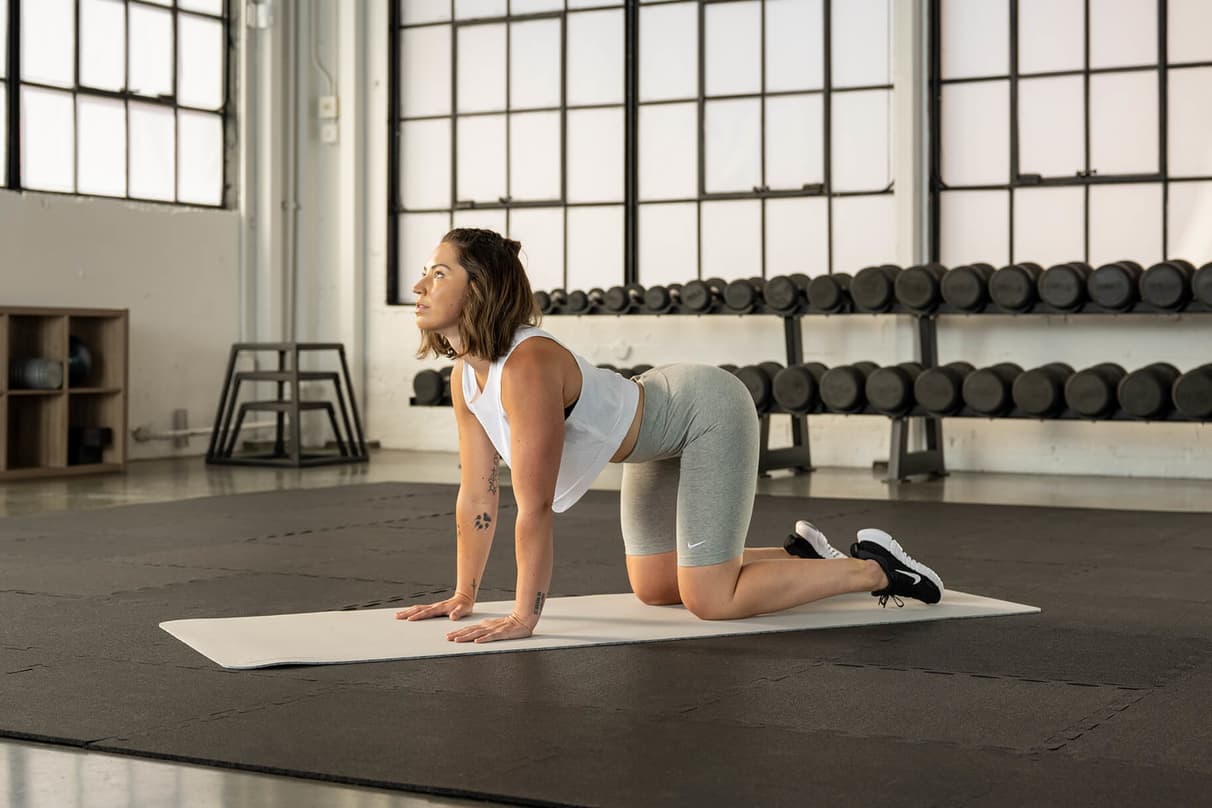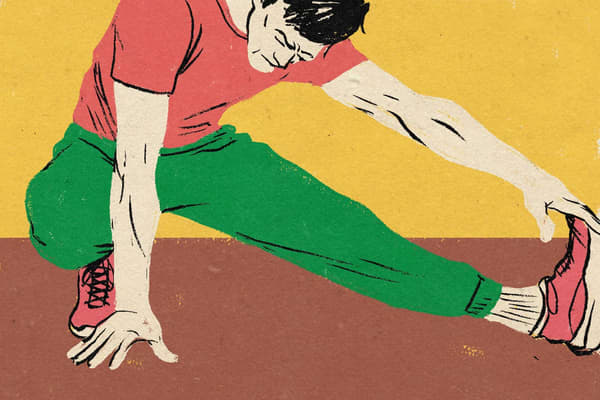How To Create an At-home Morning Stretch Routine
Health & Wellness
Plus, expert commentary on the benefits of morning stretches.

Have a morning routine? If you tend to brew a cup of coffee or hit "play" on a wakeup playlist, consider doing a morning stretch routine beforehand.
Flowing through some gentle movements at the start of your day will not only help to prepare your body for movement—of any kind—but it may also help improve flexibility over time. Read on to find out how to design a programme that will work best for you.
(Related: Five Simple Ways to Create a Relaxing At-home Yoga Space)
First, Plan Your Morning Stretches
1.Decide How Much Time You Have
If you only have a couple of minutes—don't sweat it. If you can spare more time, "anywhere from five to 15 minutes is a wonderful place to start", said Kyle Kercher, PhD, CSCS, PMP, assistant professor of sport management at the School of Public Health-Bloomington, Indiana University.
"Start small and slowly build up from there, while being realistic with what you can fit into your morning routine. Some is always better than none when it comes to stretching and exercising", Kercher said.
2.Pinpoint Which Areas Need Attention
If you have injuries or chronic conditions, like osteoarthritis, be sure to contact your doctor or a licensed physiotherapist to help prescribe the appropriate stretches. Also, consider taking a moment to scan your body for any spots with tension or slight discomfort.
"Maybe you slept terribly, so you feel your shoulders clenched up to your ears", said Kristen Crowe, BC-DMT, NASM CPT. "Just take a minute to move your neck and drop your shoulders as you take a few deep breaths", she said.
3.Try To Pick Compound Movements that Target Major Muscle Groups
Debbie Dy, DPT, said that compound movements are important to take into consideration so you can recruit several muscles in just one movement rather than having to do multiple isolated ones.
(Related: Everything You Need To Know About Compound Exercises)
Consider This Baseline Routine
If you don't have time to go to a morning yoga class, no problem—there are plenty of movements you can do on your own right at home to relieve tension.
Dy recommended following this sequence of moves, performing each stretch for two to four repetitions of 30 seconds each to increase flexibility. However, before getting started, it's always a good idea to consult with a licensed physiotherapist, certified personal trainer or doctor.
7 Movements To Include In Your Morning Stretch Routine
1.Cat/Cow

This pose provides relief to the neck and back and engages the core, strengthening the abdominal muscles.
To perform:
- Get in a quadruped position (also known as Tabletop in yoga) with your hands shoulder-width apart and knees below your hips.
- Inhale while curving your lower back and raising your head, tilting your hips up.
- Exhale and bring in your abdomen, arching your spine and lowering your head and hips.
- Repeat about five times to start
2.Child's Pose

With this movement, you'll open the hips, increase blood flow to the head and neck, focus on the spine and relax the back muscles and hips.
To perform:
- Start in Tabletop position.
- Bring your knees wide and your big toes to touch. Sink your hips back towards your heels.
- Leaning forwards, keep your bottom on your heels and place your forehead on the floor.
- Move your arms beside your legs, palms up. Inhale and exhale several times.
3.Thread The Needle

To stretch and open the shoulders, chest, arms, upper back and neck, try this pose.
To perform:
- Start in the quadruped position. Extend your arms out and fold your torso back over your hips.
- Exhale and slide your right arm underneath your left arm, palm facing up.
- Slide your right shoulder down to the ground.
- Rest your cheek and right ear on the ground, while looking to the left. Hold for about a minute.
- Press up through your left hand and slide your right hand back towards the right side of the body so that it's directly under your shoulder.
- Return to quadruped position.
- Repeat on the opposite side.
4.Seated Side Stretch

Add this movement, which stretches and strengthens the muscles between the ribs, to your routine as it ultimately helps to facilitate deeper breathing.
To perform:
- Sit in a chair with your feet flat on the floor.
- Lean as far as you can to your left side, raising your right arm and bending your upper body to the left. Try to look up towards your right hand.
- Hold for 20 seconds, then return to your starting position.
- Repeat twice before switching sides.
5.Upper Trap Stretch

This pose helps to reduce tightness in the neck.
To perform:
- Sit down either in a chair or on the floor in a cross-legged position.
- Place your left hand over the top of the right side of your head.
- With your right arm behind your back, pull your head towards your left shoulder.
- Hold for 20–30 seconds.
- Repeat two or three times before switching arms and directions.
6.Shoulder Rolls

With this pose, you stretch the muscles and tendons and promote joint lubrication in the shoulders, helping to reduce tension.
To perform:
- Stand with your arms by your sides and feet shoulder-width apart.
- Shrug your shoulders up towards your ears, then back down.
- Gently rotate your shoulders forwards, making large circles.
- Repeat the same movement, backwards.
7.Standing Forward Fold

Choose this pose to help stretch the spinal column, backs of the legs and back muscles.
To perform:
- Stand with your feet facing forwards and arms at your sides.
- Exhale and hinge at the hips, bringing your palms flat to the floor and your head pressed to your knees.
- Hold for several seconds. Inhale and move back into your standing position.
Why Stretching Is So Important
"Incorporating a morning stretch routine can have immense physical and mental health benefits", Dy said.
Perhaps the biggest boon of adopting a stretching routine is that it helps to reduce the risk of injury. Everyday activities, like sitting for long periods of time, can cause muscles to tense and spasm, for instance. When this occurs, muscles may not respond the way you need them to, making them more prone to damage and injury, Dy explained.
By stretching in the morning, you'll help increase the flow of oxygen-rich blood to the muscles, boosting flexibility and mobility later in the day.
How Often Should You Engage in a Morning Stretch Routine?
The frequency of your morning flow practice is up to you. According to Dy, the general recommendation from the American College of Sports Medicine is to begin with an active warm-up (like walking on the treadmill for 10 minutes), followed by stretching, at least two or three times a week.
That said, "there's no harm in stretching daily", said Kelcie Wittman, DPT, spokesperson for the American Physical Therapy Association. Just consider checking with your doctor if you're pregnant or have a medical condition that might pose an issue.
"The number of times a week you stretch is based on your physical activity level, goals, other health conditions and personal preference", Wittman said.
(Related: 5 Benefits of Stretching Daily, According to Experts)
Dynamic vs. Static Stretching: What's the Difference?
Dynamic stretching involves moving muscles actively through their entire range of motion, Dy explained. Think walking lunges or arm circles. Meanwhile, static stretching means holding stretches over time, like head-to-knee forward bends or seated butterfly stretches. "Both types of stretching have been shown to be equally effective at increasing range of motion", Dy said.
"A general rule for stretching is to perform dynamic stretching before exercise and static stretching after exercise", Wittman said. One caveat: Some research suggests static stretching could be more effective than dynamic stretching before sports requiring flexibility, such as ballet or gymnastics.
For your morning stretch routine, focus on dynamic stretches to warm up your muscles—especially if you'll be working out right afterwards. Try to tailor your movements to the workout you're about to do, Crowe suggested. If you plan to stretch again in the evening, you can save static stretches for your evening routine.
Should You Modify Your Morning Stretch Routine Over Time?
You don't need to switch up your morning stretches that often. However, you'll probably want to periodically make some adjustments. For example, different issues—such as injuries or sore spots—could arise, meaning different parts of the body may require more attention than others. Second, you might want to introduce a more challenging stretch into your routine.
"The body will eventually plateau over time when doing the exact same exercises at the same intensity each day", said Hannah Daugherty, an NASM- and ACE-certified personal trainer. "Holding a stretch for a few extra seconds, reaching a bit further in a stretch, or even adding a few more reps to a set are all excellent ways to ensure you keep making forward progress".
If you feel your routine getting stale, try changing exercises, Kercher suggested. "I've had a lot of success with clients when we've adjusted their stretch [or] exercise routine every four weeks", he said.
(Related: The Top 3 Yoga Poses To Get Stronger, According to Experts)
Consider Incorporating an Evening Stretch Routine, As Well
Consider adding a stretch routine right before bed. Since the goal of this type of practice is to relax the muscles before bedtime, Daugherty recommended engaging in slower static movements.
If you can, incorporate breathwork, which can aid with stress reduction, Dy suggested. As for which stretches to include, Crowe recommended relaxing restorative yoga poses, like Legs Up the Wall, Child's Pose, Spinal Twists and Forward Folds to help promote restful sleep.
Words by Dina Cheney





